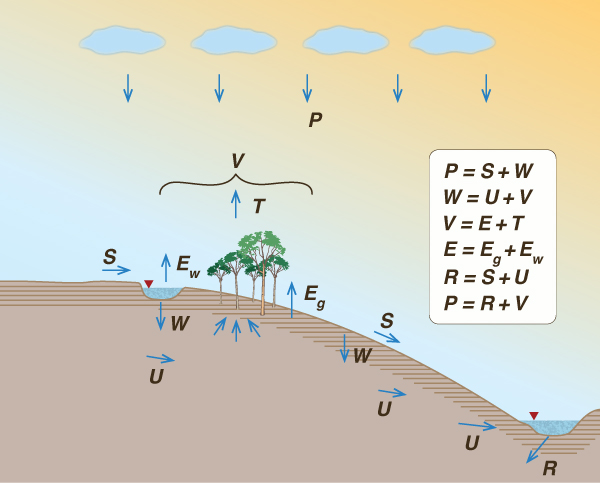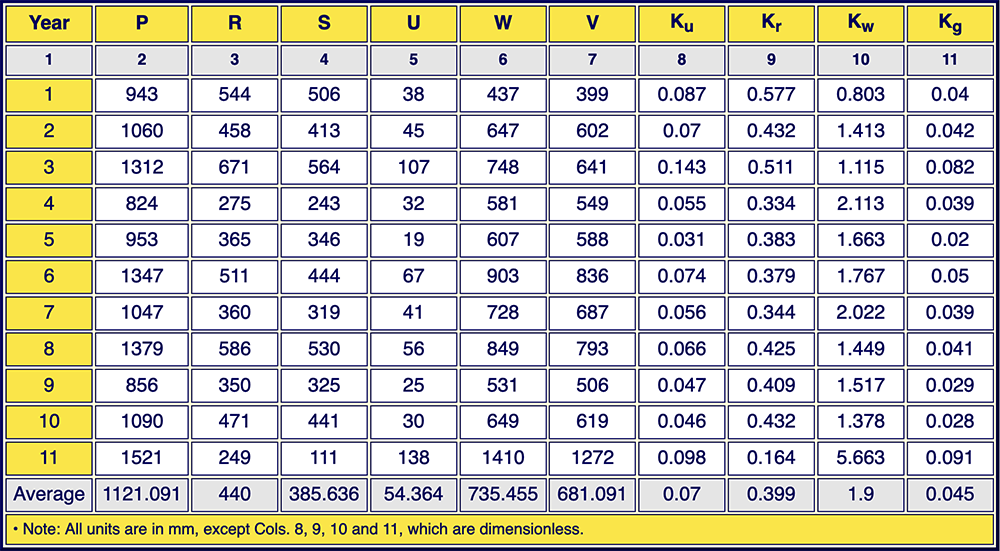|
Fig. 1
The cybernetic hydrologic balance (L'vovich, 1979).
HOW TO CALCULATE ONLINE A SUSTAINABLE GROUNDWATER RECHARGE COEFFICIENT?
Professor Emeritus of Civil and Environmental Engineering
San Diego State University, San Diego,
California
1. SUSTAINABLE USE OF GROUNDWATER
The issues regarding the sustainable use of groundwater
were brought into sharp focus with the pioneering work of
Sophocleus (1997)
and Alley et al (1999).
More recently, these issues have been extensibly treated by
2. GROUNDWATER RECHARGE COEFFICIENT
In L'vovich's
approach, annual precipitation P is separated into two components (Fig. 1):
in which S = surface runoff, i.e., the fraction of runoff originating directly
on the land surface, and
In turn, wetting is separated into two components:
in which U = baseflow, i.e., the fraction of wetting which exfiltrates as the dry-weather flow of streams and rivers, and V = vaporization, i.e., the fraction of wetting returned to the atmosphere as water vapor. Runoff (i.e., total runoff) is the sum of surface runoff and baseflow:
Combining Eqs. 1 to 3:
Equations 1 to 4 constitute a set of water balance equations. Four water balance coefficients may be defined: (1) runoff coefficient, (2) baseflow coefficient, (3) wetting coefficient, and (4) groundwater recharge coefficient. The runoff coefficient is:
The baseflow coefficient is:
The wetting coefficient is:
The groundwater recharge coefficient is:
3. THE ONLINE CALCULATOR The online calculator ONLINEWATERBALANCE2 was developed at the Visualab, Department of Civil, Construction, and Environmental Engineering, at San Diego State University, San Diego, California. The calculator requires the following input data: INPUT DATA
Precipitation P (mm or in) is the total amount of spatially weighted measured precipitation in a given catchment for the given year.
Runoff R is the total amount of runoff at the
gaging station at the catchment mouth
for the given year.
Surface runoff S is obtained by separating, using an appropriate baseflow separation technique,
A suitable input data file is shown in the following box. The data file was originally presented
by
Figure 2 shows the results from the calculator.
Columns 2, 3, and 4 echo the input data; Columns 4 to 10 show the indicated
hydrologic variables and coefficients; and lastly,
Fig. 2 Sample output from ONLINEWATERBALANCE2.
4. CLOSING STATEMENT The calculated average value of Kg may be used as a reference to support the sustainable use of groundwater in the catchment/watershed/basin under consideration. For instance, given the average value of Kga = 0.045 for the catchment of the present example, an annual precipitation forecast Pi for the ith year and catchment/watershed/basin area Ac leads to the following volume Vi of sustainable annual groundwater pumping: Vi = Kga Pi Ac.
REFERENCES
Alley, W. M., T. E. Reilly, and O. E. Franke. 1999.
Sustainability of groundwater resources.
U.S. Geological Survey Circular 1186, Denver, Colorado, 79 p.
L'vovich, M. I. 1979. World water resources and their future.
Translation from Russian by Raymond L. Nace, American Geophysical Union.
Ponce, V. M. 2014. Engineering Hydrology: Principles and Practices,
Chapter 5, Section 5.3: Unit HYdrograph.
Ponce, V. M. . 2018.
Why is the
cybernetic hydrologic balance
better suited for yield hydrology
than the conventional approach? Online article.
Ponce, V. M. and J. Da Silva. 2018.
How much water could be pumped from an aquifer and still remain sustainable?
Online article.
Sophocleous, M. 1997. Managing water resources systems: Why "safe yield" is not sustainable? Editorial, |
| 240910 0730 |

